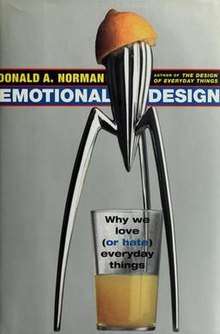Emotional Design
 | |
| Author | Donald Norman |
|---|---|
| Country | United States |
| Language | English |
Publication date | 2003 |
| ISBN | 0-465-05135-9 |
Emotional Design is both the title of a book by Donald Norman and of the concept it represents.
Content
The main topic covered is how emotions have a crucial role in the human ability to understand the world, and how they learn new things. For example: aesthetically pleasing objects appear to the user to be more effective, by virtue of their sensual appeal. This is due to the affinity the user feels for an object that appeals to them, due to the formation of an emotional connection with the object.
Norman's approach is based on classical ABC model of attitudes. However, he changed the concept to be suitable for application in design. The three dimensions have new names (visceral, behavioral and reflective level) and partially new content. In the book, Norman shows that design of most objects are perceived on all three levels (dimensions). Therefore, a good design should address all three levels. Norman also mentions in his book that "technology should bring more to our lives than the improved performance of tasks: it should be richness and enjoyment." (pg 101) He stresses the importance of creating fun and pleasurable products instead of dull and dreary ones. By mixing all three design levels and the four pleasures by Patrick W. Jordan, the product should evoke an emotion when the user is interacting with the product.
Emotional design is an important element when generating ideas for human-centred opportunities. People can more easily relate to a product, a service, a system, or an experience when they are able to connect with it at a personal level. Rather than thinking that there is one solution for all, both Norman's three design levels and Jordan's four pleasures of design can help us design for each individuals needs. Both concepts can be used as tools to better connect with the end user that it is being design for.
The visceral level concerns itself with the aesthetic or attractiveness of an object. The behavioural level considers the function and usability of the product. The reflective level takes into account prestige and value; this is often influenced by the branding of a product.[1]
Cover
The front cover of Emotional Design showcases Philippe Starck's Juicy Salif, an icon of industrial design that Norman heralds as an "item of seduction" and the manifestation of his thesis.[2]
Concept
Emotional design is also influenced by the four pleasures, identified in Designing Pleasurable Products[3] by Patrick W. Jordan. In this book Patrick W. Jordan builds on the work of Lionel Tiger to identify the four kinds of pleasures. Jordan describes these as “modes of motivation that enhance a product or a service. Life is unenjoyable without appreciating what we do, and it is human intuition to seek pleasure.” The idea of incorporating pleasure into products is to provide the buyer with an added experience. Patrick W. Jordan points out in his book that a product should be more than something functional and/or aesthetically pleasing and it should evoke an emotion through the use of pleasures. Although it is hard to achieve all four pleasures into one product, by simply focusing on one, it might be what can bring a product from being chosen over another. The four pleasures that could be implemented into products or a service are:
Physio-pleasure deals with the body and pleasure derived from the sensory organs. This includes taste, touch, and smell, as well as sexual and sensual pleasure. In the context of products, these pleasures can be associated with tactile properties (the way interaction with the product feels) or olfactory properties (the leather smell in a new car, for example).
Socio-pleasure is the enjoyment derived from the company of others. Products can facilitate social interaction in a number of ways, either through providing a service that brings people together (a coffee-maker enabling a host to provide their guests with fresh coffee) or by being a talking point in and of itself.
Psycho-pleasure is defined as pleasure which is gained from the accomplishment of a task. In a product context, psycho-pleasure relates to the extent in which a product can help in task completion and make the accomplishment a satisfying experience. This pleasure may also take into account the efficiency with which a task can be completed (a word processor with built-in formatting decreasing the amount of time spent on creating a document, for example).
Ideo-pleasure refers to pleasure derived from theoretical entities such as books, music, and art. It may relate to the aesthetics of a product and the values it embodies. A product made of bio-degradable material, for example, can be seen as holding value in the environment which, in turn, may appeal to someone who wishes to be environmentally responsible.[4]
See also
- Kansei engineering – a design approach incorporating emotional elements
- Sustainable design
References
- ↑ "Emotional Design: People and Things". www.jnd.org. Retrieved 2017-04-03.
- ↑ Norman, Donald Arthur (2005). Emotional Design. Basic Books. ISBN 0-465-05136-7.
- ↑ Jordan, Patrick (2010). Designing pleasurable products: an intro to the new human factors. London: Taylor & Francis. ISBN 978-0415298872.
- ↑ Jordan, Patrick (2004). Pleasure With Products: Beyond Usability. London: Taylor & Francis. ISBN 9780203302279.